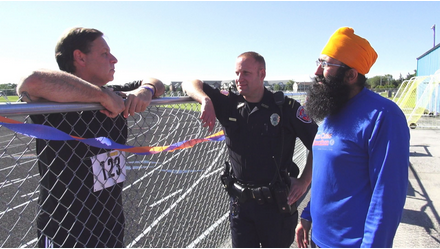Hate and bias crimes, based on race, perceived ethnicity, religion, language, nationality, sexual identity, or immigrant status, are a widespread problem within the United States. In 2015, the Bureau of Justice Statistics estimated that 207,880 hate crimes occurred in the United States. Less than 6,000 were reported to the FBI.
 |
Updated 2017
The Matthew Shepard and James Byrd, Jr. Hate Crimes Prevention Act, passed by Congress in 2009, gives the federal government the authority to investigate and prosecute crimes against victims targeted because of race, ethnicity, sexual orientation, gender identity, religion, or disability. But laws and policies alone don’t make our communities safe, and understanding the scope of the problem of hate is vital in enabling communities and law enforcement to prevent attacks based on bias and hate.
The Hate Crimes Reporting Gap is the huge disparity between those hate crimes reported to the Federal Bureau of Investigation (FBI) and those that actually occur. Because they are vastly underreported, many communities cannot address a problem they don’t even know exist.
“Underreporting leads to underenforcement, which matters because, as [Attorney General Eric] Holder said, ‘bias-motivated acts of violence divide our communities, intimidate our most vulnerable citizens, and damage our collective spirit,’” wrote the New York Times in an August 2012 editorial. The editorial concluded by saying that “[t]hese acts should be investigated and prosecuted for the broad harm they do to communities, well beyond their individual victims.”
How is Hate Crime Data Collected?
Two of the main sources for national hate crime data are conducted by the U.S. Department of Justices’ Bureau of Justice Statistics (BJS) and the FBI. These two data sources both collect data on hate crimes but have different approaches.
The BJS National Crime Victimization Survey (NCVS) is collected from a nationally representative sample of households that are interviewed twice a year about criminal victimization. The instrument collects data on frequency, characteristics and consequences of rape, sexual assault, assault, theft, motor vehicle theft, and household burglary. This information is based on nonfatal crimes and does not matter whether they were reported to the police.
The FBI Uniform Crime Reporting (UCR) Hate Crime Statistics are reported by law enforcement directly to the FBI. This data provides the number of incidents, victims, and offenders in hate and bias-related crimes whether the crime is fully or partially motivated by the bias.
The Gap: 88% of Agencies Report No Hate Crimes
In 2015 only 5,850 hate crimes were reported to the FBI by local law enforcement agencies. Yet, the BJS NCVS study showed 207,880 hate crime incidents for the same year.
Eighty-eight percent of law enforcement agencies that participate in the program reported no hate crimes in their jurisdictions. “The primary differences between the UCR and NCVS programs relate to victim reporting to the police and how police process and classify incidents as hate or bias-motivated,” according to the BJS.
Why are hate crimes not reported?
 The NCVS report surveyed victims and found that 23% of the responders in 2011–2015 said they did not report the crime because they did not believe the police could or would help.
The NCVS report surveyed victims and found that 23% of the responders in 2011–2015 said they did not report the crime because they did not believe the police could or would help.
These statistics point out the reluctance of many targeted groups to deal with police due to historical difficulties with police departments or a feeling that their interests will not be protected. This is exemplified by the Not In Our Town film Light in the Darkness. Here, the victimization of the Suffolk County, New York town of Patchogue’s Hispanic community by young men was widely known, but the attacks went unreported by the Hispanic community because of their lack of trust in the police department. This series of hate crimes culminated with the killing of Ecuadorian immigrant Marcelo Lucero.
This story points directly to the need for law enforcement to be leaders in this crisis and to form a solid leadership network to reach out to community partners and victims.
Addressing the Gap
 Not In Our Town has created tools and trainings for both law enforcement and communities around addressing and preventing hate crimes.
Not In Our Town has created tools and trainings for both law enforcement and communities around addressing and preventing hate crimes.
In addition to the Light in the Darkness documentary, Not In Our Town films provide models of how communities and law enforcement can work together on this important issue.
- Waking in Oak Creek (33:00) profiles a suburban town rocked by hate after six worshipers at a Sikh Temple are killed by a white supremacist. In the year following the attack, the film highlights a community and law enforcement working together to overcome tragedy, stand up to hate, and create a safe town for all. Discussion guides and law enforcement resources are available with the film.
- A Prosecutor’s Stand (21:00) follows San Francisco Assistant District Attorney Victor Hwang as he brings hate crime charges against perpetrators who brutally attack a Mayan dishwasher, an African American homeless man, and a transgender woman. While hate crime charges are hard to prove, Hwang raises awareness about the importance of reporting and prosecuting hate, and works with the community to seek justice for the victims.
- Law Enforcement: Find case studies of best practices in law enforcement agencies, profiles of law enforcement leaders and short films to show at community meetings or roll call at NIOT.org/COPS.
- Stay tuned for upcoming stop hate action kits for communities, law enforcement, and schools at stophateaction.org.
- Learn more about the Not In Our Town Netowrk here or Email us at info@niot.org or call us at 510-268-9675.